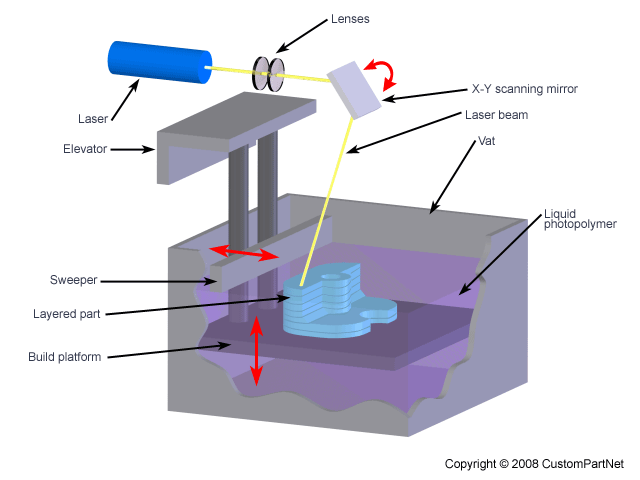 Then, a resin-filled blade sweeps across the cross section of the part, re-coating it with fresh material. On this new liquid surface, the subsequent layer pattern is traced, joining the previous layer. A complete 3-D part is formed by this process. After being built, parts are immersed in a chemical bath in order to be cleaned of excess resin and are subsequently cured in an ultraviolet oven.
Stereolithography requires the use of supporting structures which serve to attach the part to the elevator platform, prevent deflection due to gravity and hold the cross sections in place so that they resist lateral pressure from the re-coater blade. Supports are generated automatically during the preparation of 3D Computer Aided Design models for use on the stereolithography machine, although they may be manipulated manually. Supports must be removed from the finished product manually, unlike in other, less costly, rapid prototyping technologies.
Then, a resin-filled blade sweeps across the cross section of the part, re-coating it with fresh material. On this new liquid surface, the subsequent layer pattern is traced, joining the previous layer. A complete 3-D part is formed by this process. After being built, parts are immersed in a chemical bath in order to be cleaned of excess resin and are subsequently cured in an ultraviolet oven.
Stereolithography requires the use of supporting structures which serve to attach the part to the elevator platform, prevent deflection due to gravity and hold the cross sections in place so that they resist lateral pressure from the re-coater blade. Supports are generated automatically during the preparation of 3D Computer Aided Design models for use on the stereolithography machine, although they may be manipulated manually. Supports must be removed from the finished product manually, unlike in other, less costly, rapid prototyping technologies.One of the advantages of stereolithography is its speed; functional parts can be manufactured as shortly as within a day. The length of time it takes to produce one particular part depends on the size and complexity of the project and can last from a few hours to more than a day. Most stereolithography machines can produce parts with a maximum size of approximately 50×50×60 cm (20"×20"×24") and some, such as the Mammoth stereolithography machine (which has a build platform of 210×70×80 cm),[8] are capable of producing single parts of more than 2 m in length. Prototypes made by stereolithography are strong enough to be machined and can be used as master patterns for injection molding, thermoforming, blow molding, and various metal casting processes. Although stereolithography can produce a wide variety of shapes, it is often expensive; the cost of photo-curable resin ranges from $80 to $210 per liter, and the cost of stereolithography machines ranges from $100,000 to more than $500,000. However, recent interest and technological advances are bringing the cost of stereolithography machines down in price exponentially.
The term “stereolithography” was coined in 1986 by Charles (Chuck) W. Hull,who patented it as a method and apparatus for making solid objects by successively "printing" thin layers of the ultraviolet curable material one on top of the other. Hull's patent described a concentrated beam of ultraviolet light focused onto the surface of a vat filled with liquid photopolymer. The light beam draws the object onto the surface of the liquid layer by layer, and using polymerization or cross-linking to create a solid, a complex process which requires automation. In 1986, Hull founded the first company to generalize and commercialize this procedure, 3D Systems Inc, which is currently based in Rock Hill, SC. More recently, attempts have been made to construct mathematical models of the stereolithography process and design algorithms to determine whether a proposed object may be constructed by the process.
On September 26, 2012, Formlabs (a company formed by former members of the MIT media lab) released the Form 1 3D printer, which is currently the cheapest 3D printer using the stereolithography process on the market. The printer includes a build envelope of 125 x 125 x 165 mm and a resolution of 300 microns. Formlabs also developed software that takes STL models and allows users to generate "smart" support structures that allow for overhangs and more complex geometries. The kit is currently being sold through Kickstarter for $2299. Depending on the success of the kick-start venture the Form 1 3D printer will be in competition with Fused deposition modelling (FDM), reprap and Makerbot printers.
 In comparison with FDM, optical fabrication offers smoother surfaces and finer printing resolution within its print layers. The main disadvantage is that the print material is not interchangeable. While reprap uses a ABS, Polylactic acid with high stiffness properties, the Form 1 printer has a liquid based ultraviolet curable photopolymer "resin". Also the cost of photo-curable resin ranges from $80 to $210 per liter, the main question will be cost over quality. In future there might be two systems leading the manufacturing revolution of 3D printing, but for now the well established fused deposit model is winning, because its simply cheaper.
In comparison with FDM, optical fabrication offers smoother surfaces and finer printing resolution within its print layers. The main disadvantage is that the print material is not interchangeable. While reprap uses a ABS, Polylactic acid with high stiffness properties, the Form 1 printer has a liquid based ultraviolet curable photopolymer "resin". Also the cost of photo-curable resin ranges from $80 to $210 per liter, the main question will be cost over quality. In future there might be two systems leading the manufacturing revolution of 3D printing, but for now the well established fused deposit model is winning, because its simply cheaper.



No comments:
Post a Comment